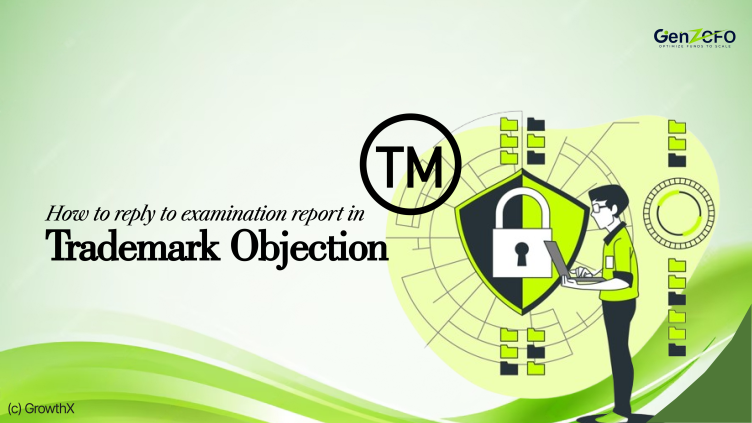How to reply to examination report in trademark objection?

Reply to Trademark Objection
Receiving an examination report with objections from the trademark registry can feel challenging, but understanding how to address these objections can strengthen your trademark’s eligibility. Sections 9 and 11 of the Indian Trademark Act, 1999, frequently serve as the basis for objections, dealing respectively with distinctiveness and similarity to existing marks. An examination report in the trademark registration process serves as the registrar’s preliminary assessment, listing any objections to the mark. Addressing these objections properly is a must for the success of a trademark application.
This GrowthX article by CA Manish Mishra will provide a professional guide on how to effectively reply to an examination report, covering key provisions, steps, and examples to help applicants understand the process.
Trademark Examination Reports
When an application is filed, it undergoes examination by the trademark registry. The examination report may object to the trademark based on various sections of the Trademarks Act, primarily Sections 9 and 11:
- Section 9 objections typically arise due to lack of distinctiveness or descriptiveness.
- Section 11 objections address the likelihood of confusion with pre-existing trademarks.
Common Sections Invoked in Objections
Section 9: Lack of Distinctiveness
Section 9 objections are raised when a trademark is deemed non-distinctive or descriptive of the goods/services it represents. This includes:
- Section 9(1)(a): Prohibits marks lacking distinctiveness.
- Section 9(1)(b): Restricts descriptive marks.
- Section 9(2): Covers marks that may mislead the public.
Section 11: Similarity with Existing Marks
Section 11 objections arise when the proposed mark is too similar to an existing trademark, creating a likelihood of confusion. Key provisions include:
- Section 11(1): Likelihood of confusion with earlier trademarks.
- Section 11(2): Prohibits marks that may affect well-known trademarks.
You can book our IPR Advisory Services where you will be talking to an IP Attorney who will then understand your case and advise on what can be done in filing MIS-R or attending Ready for Show cause hearing.
Responding to Section 9 Objections
To address Section 9 objections, the applicant needs to establish the distinctive nature of the mark and demonstrate that it is not descriptive or misleading. A detailed breakdown of the relevant provisions is essential for a well-structured response.
Detailed Analysis of Section 9
The objection under Section 9 may involve the following aspects:
- Distinctiveness: The mark should be inherently distinctive or capable of acquiring distinctiveness.
- Descriptiveness: A descriptive mark should not directly convey information about the goods/services.
- Acquired Distinctiveness: In cases where distinctiveness is questioned, applicants can submit evidence showing that the mark has acquired distinctiveness through long-term use.
Case Studies on Section 9
Case Law 1: Lack of Distinctiveness
In Imperial Tobacco Co. of India Ltd. v. Registrar of Trade Marks, the mark “Capstan” was objected to under Section 9 due to lack of inherent distinctiveness. The applicant argued that the brand had acquired secondary meaning over the years, ultimately convincing the registrar to approve the mark based on acquired distinctiveness.
Case Law 2: Descriptive Marks
In Dunlop Rubber Co. v. Dunlop Pneumatic Tyre Co. Ltd., the court held that generic terms directly referring to the product's characteristics (e.g., “Tyre”) could not be trademarked under Section 9 unless the mark had acquired a unique association with the brand.
Responding to Section 11 Objections
Responding to Section 11 objections requires the applicant to demonstrate that there is no likelihood of confusion between the proposed mark and pre-existing ones.
Detailed Analysis of Section 11
Section 11 objections are typically assessed based on:
- Similarity in Appearance/Phonetics: The applicant may argue differences in visual or phonetic elements.
- Goods/Services Classes: If the goods or services of the two marks fall in different categories, the applicant can argue reduced likelihood of confusion.
- Market Position: In cases involving well-known trademarks, the applicant must show that the use of their mark will not harm the established brand.
Case Studies on Section 11
Case Law 1: Confusion with Prior Marks
In Amritdhara Pharmacy v. Satya Deo Gupta, the Supreme Court dealt with an objection on phonetic similarity between “Amritdhara” and “Lakshmandhara.” The court considered the target customer base and the slight phonetic differences to conclude that there was no likelihood of confusion, allowing the mark to proceed.
Case Law 2: Well-Known Marks
In Daimler Benz v. Hybo Hindustan, the court upheld objections based on Section 11, where the use of the mark “Benz” for unrelated products (undergarments) was prohibited. The court highlighted that well-known trademarks like “Benz” must be protected from association with inferior goods, thus rejecting the applicant’s defense.
Drafting a Response to Examination Reports
A well-drafted reply to trademark objection should be structured to address each objection raised, providing clear arguments and legal precedents where applicable.
Key Components of the Reply
- Introduction: Reference the examination report and its objections.
- Explanation: Address each point under Sections 9 or 11, explaining why the objection is invalid.
- Evidence of Use: For Section 9 objections, include evidence showing the mark’s use in the market, demonstrating acquired distinctiveness if necessary.
- Citing Precedents: Reference relevant case laws or judicial rulings supporting the mark’s registration.
Example Response Structure
- Header: State the objection and mark details.
- Substantive Arguments: For Section 9 objections, focus on distinctiveness; for Section 11, emphasize lack of confusion.
- Legal Precedents: Mention prior cases supporting your stance.
- Conclusion: Reaffirm why the objections should be waived.
Common Errors to Avoid
Some common mistakes that can weaken a reply include:
- Missing Deadlines: Failing to respond within the stipulated timeline may result in abandonment.
- Incorrect Provisions: Misapplying or misunderstanding sections can lead to rejection.
- Inadequate Evidence: Lack of proof for acquired distinctiveness can weaken Section 9 responses.
FAQs on Replying to Examination Reports
What is the timeline for replying to an examination report?
The response is typically due within 1 month of receiving the examination report.
Will I be given an opportunity for a show-case hearing if my reply is not accepted?
Yes, applicants can appoint an attorney who can present the case in the trademark hearing.
Is evidence mandatory for acquired distinctiveness under Section 9?
Yes, showing acquired distinctiveness can significantly strengthen your response.
GenZCFO has a dedicated team of IPR Attorneys, feel free to contact us.


 CA Manish Mishra
CA Manish Mishra